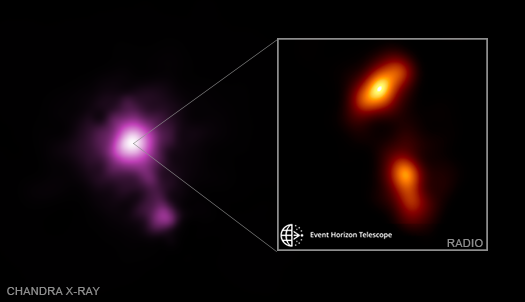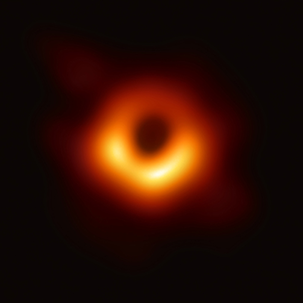A Golden Age for Exploring the Paradoxes of Black Holes
In a universe full of exotic objects, black holes still manage to stand out for their extreme behavior and the paradoxes they display. They are the darkest objects we know about, but generate so much light they can be identified across most of the observable universe. They are famous for inexorably pulling in matter, but they can also fire off jets at almost the speed of light and create structures much larger than our galaxy. They can tear stars apart, but also nurture bursts of star formation across entire galaxies.
Discoveries like these with NASA's Chandra X-ray Observatory continue to mount, along with results from its sister observatory, the Hubble Space Telescope and other telescopes. Marking a golden age for the study of black holes, these telescopes have been joined in the last few years by two remarkable observatories, the Laser Interferometer Gravitational-Wave Observatory (LIGO) and the Event Horizon Telescope (EHT).
The EHT collaboration earned worldwide acclaim a year ago in revealing the first image of a black hole. Today they released their second image, which shows an unprecedented view of the region close to a quasar called 3C 279. A quasar contains a supermassive black hole pulling in matter at an impressive rate. The energy released by the matter falling toward the black hole generates intense radiation and powerful beams of high-energy particles that blast away from the black hole at extraordinary speeds.
The 2019 EHT image showed the black hole in M87, located "only" about 60 million light years from Earth. By contrast, 3C 279 is located 5.3 billion light years from Earth, almost a hundred times farther away. This means that even the EHT's remarkably sharp vision was not able to show a ring of light around the black hole's event horizon. However, the latest EHT result did reveal the finest detail ever seen in a jet produced by a supermassive black hole, including detecting the motion of features at velocities of 99.5% of the speed of light.
Our graphic shows that the 3C 279 jet stretches out to much larger distances than the EHT image shows. In the Chandra image, the separation between the quasar and the bright X-ray source in the jet covers a distance that is about 50,000 times longer than the separation between the two radio sources in the EHT image. In other words, the separation between the two EHT sources is equivalent to only about 0.0002 times the size of a Chandra pixel, one of the tiny dots in a raw Chandra image. (Note the separation of the two Chandra sources is equivalent to about 85,000 light years at the distance of 3C 279. This corresponds to a length of about 2.4 million light years along the jet, because it is inclined at only about two degrees to our line of sight.) The Chandra and EHT images look similar overall (ie, they have the same basic components) because both detect emission from regions close to the black hole and both show parts of the same, straight jet.
This quasar is a member of a special class called blazars, where the jet is pointed almost directly at us. These objects rapidly change in brightness in many types of light, which has motivated astronomers to organize large, coordinated observing campaigns to understand their behavior. Chandra was part of such a campaign for 3C 279 in 2006, along with observations covering the full electromagnetic spectrum, from gamma-rays with the International Gamma-ray Astrophysics Laboratory (INTEGRAL), through to radio observations with several telescopes including the Australia Telescope Compact Array (ATCA) and the Sub-millimeter Array (SMA) in Hawaii. Scientists synthesized these various pieces of data to investigate the origin of 3C 279's high-energy (X-ray and gamma-ray) emission and the behavior of its jets.
Astronomers have also capitalized on the special properties of 3C 279 to probe the material lying in between the quasar and us. In 2005, they reported the use of Chandra to search for the web of tenuous, hot gas predicted to exist between galaxies. The matter in this "Warm Hot Intergalactic Medium" (WHIM) is predicted to contain about half of the normal matter in the universe. Because the imprint of the WHIM on the X-ray light from distant objects will be extremely subtle, astronomers need to observe sources that are particularly bright. They also need to be distant enough that large areas of the WHIM can be probed. Together, these requirements make 3C 279 an excellent target for WHIM searches during its bright flares. Although these advantages were not sufficient to allow detection of the WHIM, their work paved the way for future observations using the same technique.
Exciting black hole discoveries will continue to flow from observatories like Chandra, Hubble, LIGO and the EHT. The EHT collaboration is currently working on their data for Sagittarius A*, the supermassive black hole located in the middle of our galaxy. Chandra observed Sagittarius A* during the EHT's 2017 and 2018 observing runs. As principal investigator Joey Neilsen of Villanova University described in his observing proposal: "As Sgr A* is a well-known source of X-ray flares, coordinated Chandra/EHT observations offer an incredible opportunity: a chance to observe structures (e.g., hotspots) near the event horizon while tracking their high-energy variability." Neilsen also led the Chandra observations of the black hole in M87 in 2018.
We eagerly await the release of these black hole results and others from the world's leading observatories. Like other types of science, astronomers work with colleagues around the globe and use facilities all over the planet (and in space!) to tackle the very biggest and hardest questions. Today's result is a reminder of much can be learned when we combine our efforts together.
— Peter Edmonds & Megan Watzke, CXC
- Log in to post comments


